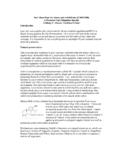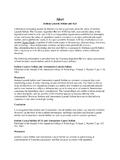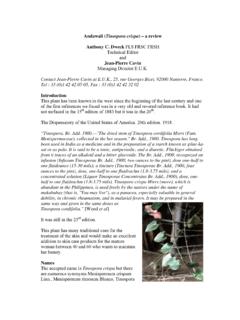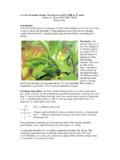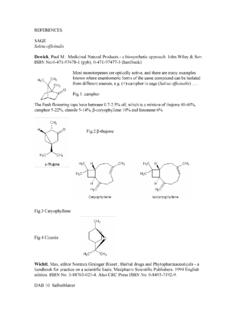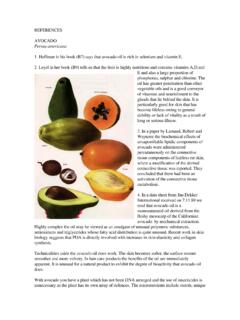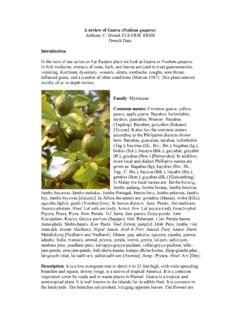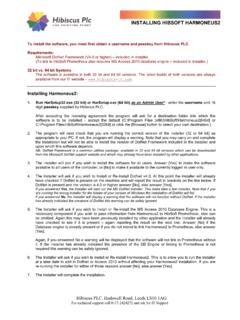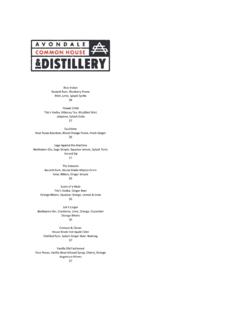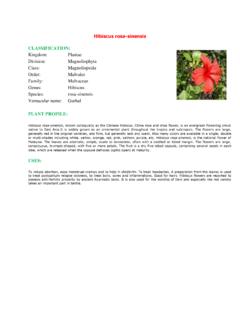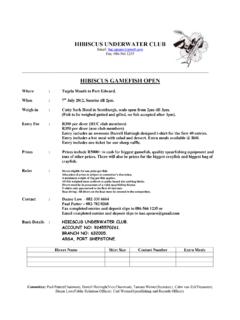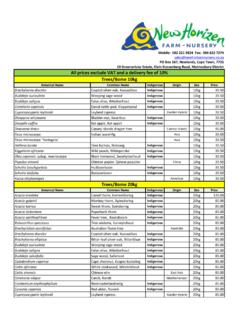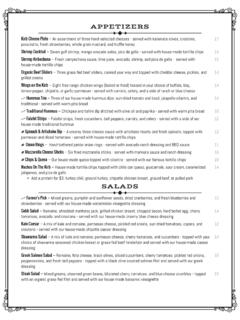Transcription of REFERENCES HIBISCUS Hibiscus abelmoschus
1 REFERENCES HIBISCUS HIBISCUS abelmoschus abelmoschus moschatus Medic. 1. Lust in his book (B8) refers to HIBISCUS as Musk-Mallow, Musk seed plant, rose mallow, Syrian Mallow, target-leaved HIBISCUS or Water mallow. It is an annual or biennial plant which grows wild in Egypt, India and the East and West Indies. It is antispasmodic, nervine, stomachic. An emulsion made from the seeds is said to be useful for spasmodic problems. An emulsion made from the milk can be used for itchy skin. In Egypt, the seeds are chewed to relieve stomach problems, to soothe the nerves, and to "sweeten" the breath. Egyptians also consider the seeds to have aphrodisiac powers. The reference goes on to mention other members of the family:- HIBISCUS bancroftianus - an herbaceous plant of the West Indies which is used like althea. HIBISCUS esculentus - okra, gumbo; found in the tropics of the Old World.
2 Both roots and fruit are used as demulcents, the leaves as emollient poultices. HIBISCUS palustris - Marsh HIBISCUS ; found in the swamps of the eastern Used like Althea. HIBISCUS rosa-sinensis - rose of China, Chinese HIBISCUS . Grown mainly for ornament, this shrub or small tree also has astringent and demulcent properties. A decoction of the roots is used as an eyewash in Malaya; the bark is used in Asia as an emmenagogue; the flowers are said to be astringent. HIBISCUS sabdariffa - Guinea Sorrel, Jamaica sorrel, roselle; a tall annual plant found in the tropics of the Old World. The herb is useful as a diuretic and refrigerant. HIBISCUS sagittifolius - a perennial herb found in Indochina. The root is said to be highly effective againsty excessive mucous discharge (blenorrhagia). HIBISCUS surattensis - a trailing shrub found in the tropical countries of Asia and Africa.
3 It is used to soothe coughs and as an emollient. HIBISCUS tiliaceus - corkwood, Cuban bast, mahoe; a shrub or tree found in tropical countries. The inner bark has mucilaginous and emollient properties HIBISCUS trionium - flower of an hour, Venice Mallow, originally from central Africa, now found as a weed in North America. The plant has mucilaginous and emollient properties. 2. Leyel (B10) refers to HIBISCUS abelmoschus which is an evergreen shrub with very large sulphur-yellow flowers based with purple. The Arabians add the seeds to their coffee and flavour soups with them. Medicinally the seeds are given for a hoarse voice. They are said to have aphrodisiac properties. In India where the musk plant is common, a tincture prepared from the seeds is much valued as an antispasmodic medicine, and is extensively prescribed for hysteria and nervous disorders.
4 3. Stuart refers to (B28) HIBISCUS sabdariffa or Roselle, Sudanese Tea, Red Tea, Jamaica Tea. HIBISCUS is the old latin name for this plant which was introduced into Jamaica and used as an acid flavouring at least as early as 1774. It contaions organic acids, comprising tartaric, citric, malic and hibiscic acids; red pigment comprising gossipetin and hibiscin; vitamin C; and also glucosides and phytosterolin. It is used as a diuretic; weak laxative and antiscorbutic. It is used in Africa and Asia as a cough remedy, wound dressing and diuretic. 4. In the Extracts from Nature Book (B47) we read that the HIBISCUS family includes over 200 species, mainly with medicinal uses. Richly emollient, HIBISCUS also calms the skin and relieves itchiness. It also sweetyens the breath, eases stomach problems, soothes the nerves and acts as an aphrodisiac.
5 (B49) refers to abelmoschus moschatus or Musk seed or muskmallow. This plant is indiginous to India; widely cultivated in tropical countries including the West Indies, Java, Indonesia and Africa. The part used is the seed. Compounds isolated include ambrettolide [(Z)-7-hexadecen-16-olide], ambrettolic acid and farnesol. Recently (Z)-5-tetradecen-14-oleide, (Z)-5-dodecenyl acetate and (Z)-5-tetradecenyl acetate have been isolated. Other compounds include methionine sulphoxide and phospholipids (alpha-cephalin, phosphatidylserine, phosphatidylserine plasmalogen, phosphatidylcholine plasmalogen) Sizable amounts of palmitic and stearic acids may also occur in the ambrette seed oil or the concrete, depending on the method of manufacture. Based on the available data, ambrette seed oil and its major odour principle, ambrettolide are non toxic.
6 HIBISCUS moscheutos Used in sophisticated perfumes, in folk medicine it is used as a stimulant and an antispasmodic; in Chinese medicine to treat headache. Later in his book he refers to HIBISCUS sabdariffa or Jamaica sorrel or Guinea sorrel. A full description of the constituents are given in the text. It is reported to have antispasmodic activity on intestinal and uteral muscles as well as antihelmintic (tapeworm) properties. Its decoction or infusion reportedly has hypotensive properties with no side effects. It is also reported to have bacteriacidal properties. Used as a flavouring. The leaves are used in Egypt for treating heart and nerve disease. It is used as a refrigerant, and has also been used in cancer. Approved for use in alcoholic beverages. 6. Weiss (B46) reports on HIBISCUS sabdariffa or Jamaica sorrel or Guinea sorrel, the main constituent is HIBISCUS acid.
7 The tea is very refreshing but has no medicinal properties. 7. Winter-Griffith (B24) reports that HIBISCUS sabdariffa or Jamaica sorrel or Guinea sorrel, Roselle is generally regarded as safe when taken in appropriate quantities for short periods of time. 8. Grieve (B6) mentions abelmoschus moschatus or Musk seed or muskmallow, where she says that an emulsion made from the seeds is regarded as antispasmodic. In Egypt the seeds are chewed as a stomachic, nervine, and to sweeten the breath and are also used as an aphrodisiac and insecticide. The seeds made into an emulsion with milk are used for itch. HIBISCUS esculentus, ocra, bendee or gumbo ios largely grown in Constantinople as a demulcent, the leaves furnish an emollient poultice. 9. In a reference from Folicon (through CPL Fragrances) we learn that it is a part of Ayurvedic medicine.
8 It contains albuminoids, soluble carbohydrates, tannins, colouring substances. Dermatologically it offers complete skin and mucous membrane compatibility. HIBISCUS rosa-sinensis known in Sanskrit as Japa or Rudhrapushpa. The roots, flowers and seeds are used. The flowers are refrigerant, emollient, demulcent and aphrodisiac; also emmenagogue. Petals are demulcent. Leaves are emollient, anodyne and aperient or laxative. HIBISCUS is useful in menorrhagia, strangury, cystitis and other conditions of the genito-urinary tract; it is also a refrigerant drink in fevers and a demulcent in cough. HIBISCUS is useful as anti-dandruff, anti-infective; prophylactic against skin diseases and allergic conditions, checks hair loss, stimulates hair growth and darkens the hair. Useful for hair care. 10. Schauenberg and Paris (B60) report on HIBISCUS sabdariffa or Sudanese Tea, Jamaica Sorrel, or Roselle.
9 It contains a red, water-soluble pigment, a mixture of organic acids (malic, citric, tartaric), and HIBISCUS acid. It is an acid tonic, well tolerated by patients with fever. It is also used to give medicine an acidic flavour. A refreshing tisane which is mildly laxative. It is also used for flavour and colour in commercially sold sachets of powdered rosehip teas. It was introduced into Europe at the end of the last century as a refreshing drink, Sudanese Tea was regarded as offensive because of its blood red colour. However, it is now used to provide a refreshing flavour in various herb tea mixtures. 11. In the Lawrence review of natural products (Oct 1990) we read that HIBISCUS sabdariffa is also known as HIBISCUS , karkade, red tea, red sorrel, Jamaica sorrel, rosella. It is native to tropical Africa and has elegant red flowers. Its flowers have long been used for their fragrance.
10 Fibre from the plant has been used as a Jute substitute and used to make rope. The red calyx is used in the preparation of teas, drinks, jams and jellies, and the leaves have been eaten as spinach. The plant is widely used in Egypt for the treatment of cardiac and nerve disease. It has been described as a diuretic. Used in the treatment of cancers. The leaves used as a topical emollient in Africa. The plant contains various anthocyanins about (responsible for the colour of the flowers) and other pigments. Oxalic, malic, citric and tartaric acids have been identified. These, along with 15% to 28% of hibiscic acid (the lactone of hydroxycitric acid) most likely contribute to the tartness of the herb and its teas. The flowers contain -sitosterol, traces of an alkaloid and sitosterol- -D-glucoside. The plant has been used as a mild laxative, an effect that may in part be due to the acids described above.
